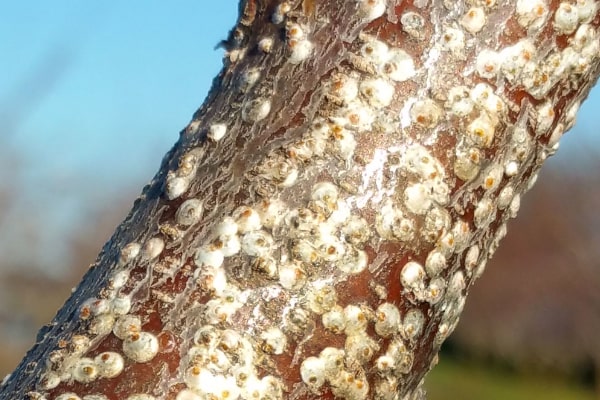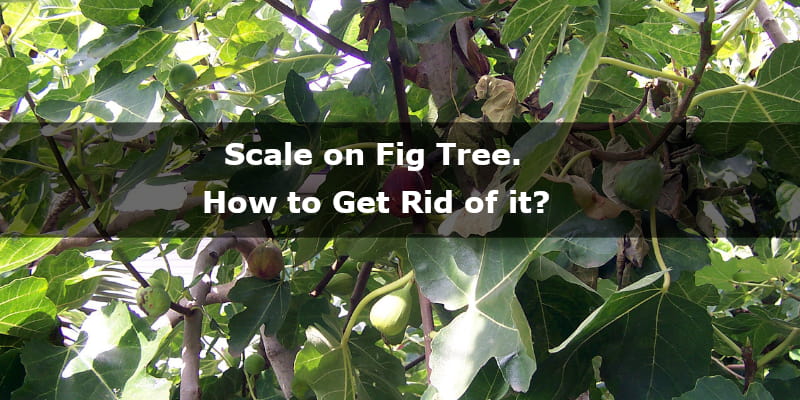Are you experiencing stunted growth of fig trees? Have the leaves of your fig trees turned yellow, or are there black spots on the leaves?
Is there more than the usual number of ants around your fig trees? Do you see bumps on tree branches that seem weird?
Your fig trees are probably infected by scales. Here is all you need to know about the scale on a fig tree.
What is Scale?
Scales are small, round, or elliptical insects that can vary in size. There are two types of scales commonly found. One is an armored scale that has a dry protective covering, while the other is a soft scale that has waxy shells and produces honeydew.
Scales can cause a lot of damage to fig plants, and it is challenging to spot the presence of scales until the damage is made apparent.
Scales can easily hide in the little spaces. Scales can hide in the air layers if you are carrying out the process of air layering.
If you have many plants and they are placed together, it means you are offering hiding pots to scales. Besides, scales can be found on the parts you have recently grafted and the parts where you have stacked the plant near the base.
In a nutshell, any little spot of your fig tree can offer habitat to scales.
How to Identify the Presence of Scale?
The first step of dealing with scale infection is identifying whether the fig tree is actually affected by scales. So, here are some symptoms that can help you confirm the presence of scales on your fig trees.
- Honeydew drippings on fig trees
- More than a normal number of ants or wasps (most probably attracted by honeydew)
- Yellow leaves
- Black spots on leaves
- Stunted plant growth.
If you see any of these symptoms, you must carefully examine the trees to see if there are scales. Though scales are hard to locate because they blend in or hide in narrow spots, you can find them with a thorough inspection.
Take a look at the picture below to see how scale looks like.

Why Did Scale Attack Your Fig Tree?
Scales grow in warm and dry environments. So, if you are growing fig trees in warm and dry locations, it is likely to be infected by scales. Besides, growing fig trees in a dirty pot can also cause the growth of scales.
Though reusing plant pots is not bad, you must clean the plant pots properly before reusing them. Besides, ensure the environment is not too harsh to facilitate the growth of scales.
Related: How Long Does Fig Tree Live? (Explained)
What are the Consequences of Scale on Your Fig Tree?
Scales are dangerous for fig trees. They can kill or stunt the growth of plants, provide a suitable environment for fungal growth, attract insects or wasps, etc.
Here are some consequences you will have to deal with once your fig tree is affected by scales.
- Stunted Plant Growth: Scales on fig trees can adversely affect plants’ growth. It can stop the plant from growing or even kill the plant. Sometimes, the plant grows, but the fruit isn’t formed. It is also one of the adverse effects of scales.
If a plant has to deal with more extended periods of scale presence, it is likely it won’t grow, and the revival of such plants is even more difficult or, in some situations, impossible.
- Fungal Infections: As mentioned earlier, scales produce honeydew. If the honeydew is left unchecked and it keeps dripping through the plant, it will eventually give birth to sooty mold, a fungus that causes the development of black spots on the leaves of the affected plant.
Sooty mold can reduce the rate of photosynthesis in leaves. Thus, it affects the normal growth of plants.
- Attract Insects and Pests: Honeydew produced by scales is the favorite food for ants and wasps. So, if your fig trees are affected by scales, it is likely you will spot abnormal amounts of ants or wasps around the trees.
Though it is a great way of confirming the presence of scales, it affects your fig trees negatively. So, make sure you take this problem into account.
- Negative Impacts on Air Layering: Scales love to hide in narrow spots. Talking about narrow spots, what’s a better spot than air layers? If you have done air layering on fig trees and they are affected by scales, there is a high probability the air layers will get infected by scales.
So, when looking for scales, make sure you check the air layers. Though scales are small, they can cause big problems. Don’t ignore their presence.
Are Fig Fruits Good to Eat Even Though They Had Scale on it?
It depends on how much the scales have penetrated the fruit. If there are only a few scales on the branches of the trees, the fruit is probably safe to eat.
Most of the time you are just making an intellectual call. You need to see for yourself if the infestation has spread to a dangerous level, it is not advised to eat the fruit.
How to Get Rid of Scale on Your Fig Tree?
Getting rid of scales is easy. You can wipe the branches with alcohol. There are other options, such as using pesticides and sprays. You can opt for manual methods if you have a smaller population of fig trees. But you will need to use pesticides for a larger number of trees.
- Wipe Branches with Alcohol:
A straightforward way of removing scales is to clean the branches with alcohol. Alcohol helps in detaching the scales from the branches.
It is an ideal option for moderate infestations. Besides getting rid of scales, it also gives a shine to the leaves, which is a lovely addition to your house plants.
- Use Toothpicks:
You can get rid of scales by picking them off manually from the plants. Though the process requires extra care, it is a suitable option if there are a few scales on the tree.
You can use any sharp-edged thing for this purpose. However, the most suitable choice, mostly used by gardeners, is a toothpick.
As scales hide in narrow spots, toothpicks can get into the narrow spots without damaging the wood. So, they are the most hassle-free option.
You might not be able to pick off all the scales from the tree, but doing it often would disrupt their life cycle.
Adult scales are usually easier to spot. So, if you can find and pick off adult scales, the life cycle would stop, and the infestation would gradually end.
- Use Insecticide:
Using pesticides can also help in getting rid of scales. Bonide Annual Tree and Shrub Insect Control (buy it here) is a great option for scales. It gets absorbed into the plant through the plant’s roots and kills any pest that feeds on that plant.
Sprays are usually ineffective for scales because of their waxy coatings and hard shells. So, the soil-drenched application of insecticides is an ideal option. It removes scales and helps protect the plant in the future.
Make sure you apply the insecticide at the base of the plant. So, it reaches the plant’s roots effectively. Water the plant regularly to help the insecticide get absorbed.
As said, the soil-drenched technique would kill any pest/insect feeding on the plant. So, applying insecticides during the pollination season is not advised, as it would harm active pollinators.
How to Prevent Scale on Your Fig Tree in the Future?
You can prevent scale infestation by whitewashing trees, examining the trees regularly, and attracting beneficial insects to your garden.
Take the following preventive measures to keep scales away from your fig trees.
- Whitewash the Trees: Though it might seem like a common practice with nothing to do with scales, many people claim it to be beneficial for preventing scale infestations. One or two coats of Rust-Oleum chalked paint (buy it here) would be enough for your fig trees.
- Examine the Trees Regularly and Diligently: The most important prevention is to be diligent. Examine the plant regularly for any harmful activity.
As soon as you spot any sign of scales, remove them immediately or isolate the affected plant from the rest of the trees to contain the infestation.
The benefit of regular examination is that you won’t have to deal with larger infestations. The earlier you identify a disease or pest, the easier it is to deal with it.
- Attract Beneficial Insects to Your Garden: You can keep a check on the propagation of scales in your garden by attracting beneficial insects.
For example, ladybugs are natural predators of scales. So, if you attract ladybugs to your garden, it is unlikely scales will attack your fig trees. Even if they do, ladybugs will deal with them before they harm your fig trees.
You can attract beneficial insects by growing some specific plants in your garden. Please do research on which insect you want to attract and which plants help the cause.
So, take these precautionary measures to prevent yourself from the hassle of dealing with scale infestations and keep your fig trees healthy.
References
bobvila.com, gardeningknowhow.com, youtube.com, youtube.com, fiddleleaffigplant.com, melindamyers.com

